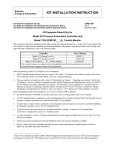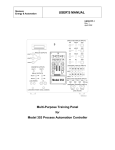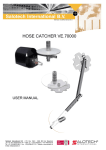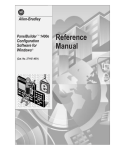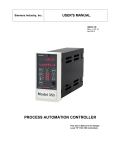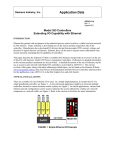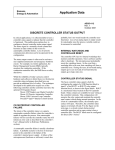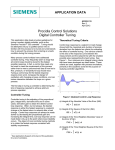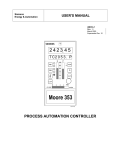Download Display - Service, Support
Transcript
Siemens Industry, Inc. INSTALLATION GUIDE IG353-1 Rev 4 June 2010 PROCESS AUTOMATION CONTROLLER Design Levels A and B IG353-1 Contents TABLE OF CONTENTS SECTION AND TITLE PAGE PREFACE .................................................................................................................................................... ii 1.0 INTRODUCTION ............................................................................................................................................. 1-1 1.1 PRODUCT DESCRIPTION.......................................................................................................................... 1-1 1.2 CONFIGURATION ...................................................................................................................................... 1-3 1.3 PRODUCT LABELS..................................................................................................................................... 1-3 1.4 TYPICAL SHIPMENT CONTENTS............................................................................................................ 1-4 1.5 CUSTOMER/PRODUCT SUPPORT ........................................................................................................... 1-5 2.0 INSTALLATION .............................................................................................................................................. 2-1 2.1 INSTALLATION CONSIDERATIONS....................................................................................................... 2-1 2.2 ENVIRONMENTAL CONSIDERATIONS ................................................................................................. 2-2 2.3 MECHANICAL INSTALLATION............................................................................................................... 2-2 2.3.1 Installing Removable Connectors and Cover........................................................................................ 2-2 2.3.2 Panel and Rack Mounting Guidelines................................................................................................... 2-3 2.3.3 Station Mounting................................................................................................................................... 2-4 2.4 ELECTRICAL INSTALLATION ................................................................................................................. 2-4 2.4.1 Wiring Guidelines ................................................................................................................................. 2-5 LIST OF ILLUSTRATIONS FIGURE AND TITLE 1-1 1-2 1-3 2-1 2-2 2-3 2-4 2-5 PAGE Model 353, Design Level A ............................................................................................................................... 1-2 Model 353, Design Level B ............................................................................................................................... 1-2 Sample Product Labels....................................................................................................................................... 1-3 Cover Installation and Removal......................................................................................................................... 2-2 Panel Cutout Dimensions ................................................................................................................................... 2-3 Model 353 Dimensions ...................................................................................................................................... 2-3 Case Mounting Clip ........................................................................................................................................... 2-4 Rear Terminal Layout and Terminal Assignments............................................................................................. 2-7 LIST OF TABLES TABLE AND TITLE PAGE 1-1 Hardware/Features for Design Levels A and B ................................................................................................. 1-1 2-1 Rear Terminal Assignments ............................................................................................................................... 2-8 PAC 353 is a trademark of Siemens Industry, Inc. All product designations may be trademarks or product names of Siemens Industry, Inc. or other supplier companies whose use by third parties for their own purposes could violate the rights of the owners. Siemens Industry, Inc. assumes no liability for errors or omissions in this document or for the application and use of information included in this document. The information herein is subject to change without notice. Procedures in this document have been reviewed for compliance with applicable approval agency requirements and are considered sound practice. Neither Siemens Industry, Inc. nor these agencies are responsible for product uses not included in the approval certification(s) or for repairs or modifications made by the user. June 2010 i Contents IG353-1 PREFACE Conventions and Symbols The following symbols may be used in this manual and may appear on the equipment. The reader should be familiar with the symbols and their meanings. Symbols are provided to quickly alert the reader to safety related text. Symbol DANGER Meaning Indicates an immediate hazardous situation which, if not avoided, will result in death or serious injury. WARNING Indicates a potentially hazardous situation which, if not avoided, could result in death or serious injury. CAUTION Indicates a potentially hazardous situation which, if not avoided, may result in minor or moderate injury. CAUTION NOTICE IMPORTANT Note Indicates a potentially hazardous situation which, if not avoided, may result in property damage. Indicates a potential situation which, if not avoided, may result in an undesirable result or state. Identifies an action that should be taken to avoid an undesirable result or state. Identifies supplemental information that should be read before proceeding. Electrical shock hazard – Either symbol indicates the presence of an electrical shock hazard. The associated text states the nature of the hazard. Explosion hazard – Symbol indicates that the danger of an explosion hazard exists. The associated text states the nature of the hazard. Electrostatic discharge – The presence of this symbol indicates that electrostatic discharge can damage the electronic assembly. Pinch hazard – Symbol indicates that a pinch hazard exists if correct procedures are not followed. Scope This manual provides basic mechanical and electrical installation information for use by experienced installers. It is to be used in conjunction with a Model 353 User’s Manual, supplied on the Siemens Process Instrumentation User Manual CD included with the controller shipment. This manual does not purport to cover all details or variations in equipment or to provide for every possible contingency to be met in connection with installation, operation, or maintenance. Should further information be desired or should particular problems arise which are not covered sufficiently for the purchaser’s purposes, the matter should be referred to a support group listed in the Customer/Product Support section of this manual or to a ii June 2010 IG353-1 Contents local Siemens sales office. The contents of this manual shall not become part of or modify any prior or existing agreement, commitment or relationship. Warranty The sales contract contains the entire obligation of Siemens. The warranty contained in the contract between the parties is the sole warranty of Siemens. Any statements continued herein do not create new warranties or modify the existing warranty. Qualified Persons The described equipment should be installed, configured, operated, and serviced only by qualified persons thoroughly familiar with this guide and the User’s Manual. For the purpose of these documents and the product labels, a qualified person is one who is familiar with the installation, assembly, commissioning, and operation of the product, and who has the appropriate qualifications for their activities such as: • Training, instruction, or authorization to operate and maintain devices/systems according to the safety standards for electrical circuits, high pressures, and corrosive, as well as, critical media. • For devices with explosion protection: training, instruction or authorization to work on electrical circuits for systems that could cause explosions. • Training or instruction according to the safety standards in the care and use of suitable safety equipment. General Warnings and Cautions WARNING The perfect and safe operation of the equipment is conditional upon proper transport, proper storage, installation and assembly, as well as, on careful operation and commissioning. The equipment may be used only for the purposes specified in this manual. CAUTION Electrostatic discharge can damage or cause the failure of semiconductor devices such as integrated circuits and transistors. The symbol at right appears on a circuit board or other electronic assembly to indicate that special handling precautions are needed. • • A properly grounded conductive wrist or heel strap must be worn whenever an electronics module or circuit board is handled or touched. Static control kits are available from most electrical and electronic supply companies. Electronic assemblies must be stored in static protective bags when not installed in equipment. ! June 2010 iii Contents IG353-1 Changes for Revision 4, June 2010 Section Cover Section 1, Introduction Section 2, Installation iv Change Banner updated Revision number and date changed Figure 1-3 and Customer/Product Support updated Updated Section 2.4.1 Wiring Guidelines and the notes in Figure 2-5 and Table 2-1 June 2010 IG353-1 Contents 1.0 INTRODUCTION This Installation Guide contains mechanical and electrical installation procedures for Siemens 353 Process Automation Controllers, Design Level A and Design Level B. It is intended for use by experienced installers. The Design Levels support various hardware (circuit board) assemblies and performance features as shown in Table 1-1. Detailed product specifications and procedures to bench test, install, configure, calibrate, and service the 353 are included in the appropriate 353 User’s Manual. Table 1-1 Hardware/Features for Design Levels A and B Controller Design Level Hardware/Features Supported • • A • B • • • • User’s Manual ID MPU Controller Board and optional I/O Expander Board Option Boards for LIL or Ethernet communications, LonWorks remote I/O, Real Time Clock and Configuration Backup MODBUS communications is standard - See Figure 1-1 UM353-1 MPU Controller Board and optional I/O Expander Board MultiMediaCard for configuration backup Real Time Clock is standard Ethernet and MODBUS communications are standard - See Figure 1-2 UM353-1B User’s Manuals are located on the supplied Siemens Process Instrumentation User Manual CD. Perform the brief procedure below to access the manuals. The manuals are in Portable Document Format (PDF). A link for downloading the free Adobe® Reader® is provided. 1. Insert the CD into your computer’s CD drive. 2. Select the desired manual from the menu: • If autorun is enabled a menu of available manuals will appear. Click on the link to the desired manual. • If autorun is not enabled, go to Start > Run and navigate to the CD. Double click on Autorun.exe and then click Run to display the menu of available manuals. 1.1 PRODUCT DESCRIPTION The Model 353 offers the control system designer the ultimate in flexibility and capability for the implementation of continuous solutions and batch solutions. At the time this manual was printed, the controller was available in two versions: hardware design level A and hardware design level B. An exploded view of a design level A controller appears in Figure 1-1. Figure 1-2 shows a design level B controller. Design level A controllers have an MPU Controller board and revision 3 firmware. An I/O Expander board for additional I/O is an option. These controllers can also have several other option boards mounted on the MPU Controller board. These option boards provide Local Instrument Link or Ethernet network communications, LonWorks communications, and Real Time Clock/Configuration Backup capability. Refer to the labels on the controller case (see Section 1.3 Product Labels) for the model designation which specifies the installed hardware. For an explanation of each character in the model designation, refer to the UM353-1, Section 14 Model Designation and Specifications. Design level B controllers have an MPU Controller board and revision 4 firmware. An I/O Expander board for additional I/O is an option. These controllers provide enhanced performance with an advanced microprocessor and additional memory, standard Ethernet communications, and configuration backup to a MultiMediaCard. Refer to the labels on the controller case for the model designation which specifies the installed hardware. For an explanation of each character in the model designation, refer to UM353-1B, Section 13 Model Designation and Specifications. June 2010 1-1 Introduction IG353-1 Connector Cover* Ground Screw* Voltage Input, Approvals, and Warning Label* Mounting Clip, Top and Bottom* Warning and I/O Capacity Label* Nameplate* LIL or Ethernet Network Board I/O Expander Board RTC/CB or RCB Board Removable Portions of Connectors* Accessory or Option Boards Connector Socket Assembly* Future Use Mounting Kit, Accessory Boards LonWorks Board MPU Controller Board Ethernet Cable MG00392b RJ-45 Ethernet Connector* Case with Flange* O-Ring, Display Assembly Display Assembly with Operator Faceplate Communication Port on Underside * = Case Assembly Flip-Down Door with Loop ID Card Warning Label FIGURE 1-1 Model 353, Design Level A Connector Cover* Ground Screw* Voltage Input, Approvals, and Warning Label* Mounting Clip, Top and Bottom* O-Ring, Display Assembly Warning and I/O Capacity Label* Nameplate* I/O Expander Board Removable Portions of Connectors* Connector Socket Assembly* RJ-45 Ethernet Connector* Case with Flange* Ethernet Connector MPU Controller Board Warning Label Display Assembly Cable MG00500a Display Assembly with Operator Faceplate Communications Port on Underside MultiMediaCard Socket Flip-Down Door with Loop ID Card * = Case Assembly FIGURE 1-2 Model 353, Design Level B 1-2 June 2010 IG353-1 Introduction 1.2 CONFIGURATION The controller must be configured before it can be used to control a process. It can be configured either locally or remotely. The local faceplate includes buttons located behind a flip-down door for complete configuration including the addition/deletion of loops and function blocks and the editing of function block parameters. Refer to the User’s Manual for detailed configuration procedures. 1.3 PRODUCT LABELS This section provides sample labels to assist in identifying the controller model at hand. IMPORTANT Before installing or servicing a controller, refer to the controller labels and the applicable specifications and hazardous area classifications in the User’s Manual to ensure that the correct model with the needed certifications is at hand. Each controller is identified by several labels located on the case and inside the drop-down door on the Display Assembly, as shown in Figure 1-1. Sample labels are shown below. Input Requirements 120/240 VAC 25 W 47-63 Hz 40 VA Max Amb. 50°C WARNING: Substitution of components may impair the suitability for Class 1, Div. 2 LR38024 WARNING: Do not connect or disconnect configuration port cable while in a hazardous location. Do not remove the rear terminal housing. Siemens Industry, Inc. Model No. 353A4F1NNLNNNA4 Sales No. nnnnnnnnnn-nnnnnn Serial No. nnnnnnnn Design Level is next to last character in Model No. Typical Input and Output Capacity: CLI, Div. 2, GPS A, B, C, & D Temp Code T4A See UM353-1 Xmtr. Pwr. Sply. Out. - 25V @ 120 mA Anlg. inp. V. - 0 to 5 Vdc @ 30uA Anlg. out. cur. - 4 to 20 mA @ 800 Ohms Dgtl. inp. V. - 0 to 30 Vdc @ 5 mAdc Dgtl. out. cur. - 100 mA @ 30 Vdc Rly. out. - 5A @ 120V, 2.5A @ 240 Vac Max. Ambient Temp 50°C FIGURE 1-3 Sample Product Labels June 2010 1-3 Introduction IG353-1 1.4 TYPICAL SHIPMENT CONTENTS The items listed below are those typically included in a shipment and are subject to change. 1. Model 353 Process Automation Controller, model number per order, qty. 1; includes mounting case, connector socket assembly and rear terminal cover 2. Power Input and Range Resistor Kit, PN 16354-30, qty. 1 DESCRIPTION Resistor, 250Ω, 0.1%, 3W, WW Sleeving Crimp-On Connector Kit Installation Instruction Shunt (Not used in Design Level B controller) 3. QUANTITY 3 3 6 1 1 Mounting Clip Kit, no part number, qty. 1 Contents: 2 Mounting Clips and 2, 8-32 x 1 Screws (see the Parts List at back of the User’s Manual for part numbers) 4. I/O Expander Board Kits PN16353-52 I/O Expander Board Kit - The I/O Expander Board is factory installed when a Model 353 with Expansion Board option 1 is ordered. • When adding an I/O Expander board to a Standard Case with Ethernet connector (case Option 4), no additional connectors need be ordered. • For field installation of this kit, see the supplied Kit Installation Instruction (15900-390). DESCRIPTION I/O Expander Board - Do not remove Board from static shielding bag until it is to be installed. Range Resistor and Reference Junction Kit, see below QUANTITY 1 1 PN16353-49 Range Resistor and Reference Junction Kit - This kit is supplied with the above I/O Expander Board Kit and with a factory shipped Model 353 with Expansion Board option 1. DESCRIPTION 4-20 mA to 1-5V Range Resistor, 250Ω, 0.1%, 3W, WW 4-20 mA to 15-75 mV Range Resistor, 3.75Ω, 0.1%, 3W, WW Sleeving Crimp-On Connector TC Reference Junction, 100Ω Kit Installation Instruction QUANTITY 1 2 5 6 2 1 5. Siemens Process Instrumentation User Manuals CD; qty 1. The CD contains UM353-1, Model 353 (Design Level A) User’s Manual and UM353-1B, Model 353 (Design Level B) User’s Manual. 6. Printed copy of Model 353 Installation Guide IG353-1 (this guide), qty. 1. 7. Two warning labels that are to be placed in a highly visible location near the case rear terminals. 8. Additional items as required by your order. Refer to the packing list accompanying a shipment. 1-4 June 2010 IG353-1 Introduction 1.5 CUSTOMER/PRODUCT SUPPORT This section provides Siemens’ Internet site addresses, e-mail address, telephone number, and related information for contacting customer/product support. IMPORTANT An instrument must be thoroughly cleaned (decontaminated) to remove any process materials, hazardous materials, or blood born pathogens prior to return for repair. Read and complete the Siemens RMA form(s). For support and the location of your local Siemens representative, refer to the table below for the URL of the Process Instrumentation (PI) portion of the Siemens public Internet site. Once at the site, click Support in the right column and then Product Support. Next select the type of support desired: sales, technical (see the table below), documentation, or software. Online Support Request http://www.siemens.com/automation/support-request Technical Support 1-800-333-7421; 8 a.m. to 4:45 p.m. eastern time, Monday through Friday (except holidays) Customer Service & Returns 1-800-365-8766 (warranty and non-warranty) Public Internet Site http://www.usa.siemens.com/pi Technical Publications in PDF Click the above link to go to the PI home page. Click Support and then Manuals and then, under “Additional Manuals,” select the product line (e.g. Control Solutions) ! June 2010 1-5 Introduction 1-6 IG353-1 June 2010 IG353-1 Installation 2.0 INSTALLATION This section outlines installation of a Siemens Model 353 Process Automation Controller. Refer to the proper Model 353 User’s Manual for detailed procedures, critical safety warnings and cautions, product specifications, and agency approvals. IMPORTANT The installation must conform to the National Electrical Code and all other applicable construction and electrical codes. Section 1.4 in this guide has a list of the items in a typical controller shipment. If the Display Assembly or one or more circuit boards must be installed in the case, go to the Assembly Replacement section of a 353 User’s Manual for installation information, including the setting of any involved jumpers. For agency approvals and installations in a hazardous area, refer to the Agency Approvals section of a 353 User’s Manual. CSA Hazardous Location Precautions and Special Conditions for Safe Use are included in the manual. Use of the equipment in a manner not specified by the manufacturer may impair the protection provided by the equipment. Two warning labels, shown here, are included with the controller. Install them in a highly visible location near the controller’s rear terminals to insure that personnel with access to controller terminals are aware of a potential electrical shock hazard and, if installation is in a hazardous area, possible explosion hazard. 2.1 INSTALLATION CONSIDERATIONS A Model 353 is intended for flush panel mounting in a vibration free instrument panel or rack in an indoor or sheltered location. Mount a single controller in a single-station panel cutout or mount several controllers in a row in a multiple-station panel cutout. For a watertight panel, mount each controller in a single-station cutout. The controller can be mounted in a user-supplied enclosure located out-of-doors or in a location whose environmental parameters exceed controller operating specifications. A thin bead of silicon sealant is often applied between the controller’s Display Assembly and the mounting panel to prevent air or liquid leakage at this joint. Do not mount the controller where direct sunlight can strike the faceplate or case. Direct sunlight can make the displays difficult to read and will interfere with heat dissipation. Mount the controller either horizontally or with a backward tilt (i.e. the front of the case higher than the rear). If the controller is to be mounted with electronic recorders or with pneumatic recorders or stations, tilt back restrictions for these units can have a bearing on panel design and layout. Route electrical power to the controller through a clearly labeled circuit breaker, fuse, or on-off switch that is located near the controller and is accessible by the operator. The breaker or switch should be located in a nonexplosive atmosphere unless suitable for use in an explosive atmosphere. Thermocouple inputs are accommodated with an I/O Expander board and a Reference Junction temperature sensor. At the factory, two Reference Junctions are included in a Range Resistor and Reference Installation Kit. June 2010 2-1 Installation IG353-1 2.2 ENVIRONMENTAL CONSIDERATIONS Operate a controller within its environmental specifications to help ensure reliable, trouble-free operation with minimum down time. Refer to the Model Designation and Specifications section of a 353 User’s Manual for controller operating temperatures limits, operating humidity, and maximum moisture content. CAUTION Exceeding the specified operating temperature limits can adversely affect performance and may cause damage to the controller. 2.3 MECHANICAL INSTALLATION The following subsections provide guidelines and procedures for mounting controllers in a panel or rack. The installation should be structurally rigid and the controllers should be squared in the panel or rack. 2.3.1 Installing Removable Connectors and Cover Typically, the cover and connectors are supplied in a bag for installation by the user. Each connector has a removable portion that can be wired and then mated to the fixed portion mounted on the back of the controller case. 1. Refer to the Electrical Installation section of this manual and connect the wiring and components (e.g. range resistors, thermocouple cold junction) to the removable portions of the supplied connectors. 2. Align the removable portion of a connector with the fixed portion on the back of the case. Press the removable portion of onto the fixed portion. Fully seat the connector. 3. Tighten the two captive screws. Do not over tighten. Check that wires and components remain connected securely. 4. Repeat the above steps for each connector. 5. Dress wires, cables, and components for cover installation. Remove the protective paper from the cover. Install the cover as shown in Figure 2-1. To Install Terminal Cover: To install or remove cover: squeeze both sides ~1/16" to clear alignment tabs. 1. Orient the cover as shown. Note the four hooked tabs and Ethernet cable clearance cutout. 2. Squeeze the cover slightly at the two small cutouts in the cover edges and fully insert the four hooked cover tabs in the rear panel slots. 3. Allow cover sides to relax. Pull the cover straight down until it snaps into place. The cutouts in the cover edges will engage two alignment tabs on the rear panel. Where needed, the Ethernet cable should exit through the large cutout in the cover. To Remove Cover: AG00327a 1. Squeeze the cover slightly at the two cutouts in the cover edges (about 2" down from the top of the cover) and push cover upward. 2. Pull cover out from rear panel. Ethernet cable cutout. FIGURE 2-1 Cover Installation and Removal 2-2 June 2010 IG353-1 Installation 2.3.2 Panel and Rack Mounting Guidelines The panel face should provide a flat and rigid mounting surface. Reinforce the back of the panel if there is a possibility that the panel face will bow. Raceways, conduit, and wiring should not interfere with accessibility of instruments, control devices, alarms, and related equipment. See Figures 2-2, 2-3, and 2-4. 5.44 +0.06/-0 [138.2 +1.5/-0] Dimensions: Inches [Millimeters] W X03100S1 Panel Cutout Dimensions: Tolerances +0.06/-0 [+1.5/-0] Height = 5.44 [138.2] Width = (2.84 X A) - 0.16 inches [(72.0 X A) - 4.1] mm Where: A= Number of 353 Stations and 353R or i|pac Faceplates FIGURE 2-2 Panel Cutout Dimensions 11.25 (285.8) 2.84 (72) 2.67 (67.8) 1.18 (30) Case Flange MG00391a TOP VIEW Mounting Clip Dimensions in inches (millimeters) SIDE VIEW 5.67 (144) 5.42 (137.7) 6.3 (160) 0.32 Max. (0.8) FIGURE 2-3 Model 353 Dimensions June 2010 2-3 Installation IG353-1 2.3.3 Station Mounting A straight slot screwdriver with at least a 10" (254 mm) shank is needed to tighten the two mounting clip screws. 1. Locate the supplied Mounting Clip Kit. It contains two mounting clips and two 8-32 x 1" fillister head screws. Thread the mounting screws into the mounting clips. See Figure 2-4. 2. At the front of the panel, insert the controller case into the panel cutout until the case flange contacts the front of the panel. 3. From behind the panel, slightly rotate the top mounting clip to fit into the case cutout. Then straighten the clip and partially tighten the mounting screw. Insert, straighten and partially tighten the bottom clip. 4. Square the case with the panel. 5. Alternately tighten top and bottom mounting clip screws until the case is secured to the panel. Do not over tighten and distort the case. Side View Insert clip as shown and straighten Bottom View X03103S0 FIGURE 2-4 Case Mounting Clip 2.4 ELECTRICAL INSTALLATION This section contains electrical connection guidelines for wiring a Model 353. Each case rear connector and terminal is identified. WARNING Electrical shock hazard Explosion hazard Can cause death or injury • • • 2-4 Remove power from all wires and terminals before working on equipment. In a potentially hazardous atmosphere, remove power from equipment before connecting or disconnecting power, signal, or other circuit. Observe all pertinent regulations regarding installation in hazardous area. June 2010 IG353-1 Installation 2.4.1 Wiring Guidelines Electrical Connections - Power, I/O, and network connections to a basic controller are completed through removable connectors using terminals H, N, and 3-26. When the controller includes an I/O Expander board, connectors with terminals 27-52 are also used. The case has an Ethernet connector for use when an Ethernet capability is included and the MPU Controller board firmware is V2.4 or later. Connector locations are shown in Figure 2-5. Individual terminals functions are also identified in Table 2-1. Connectors - Power terminals are identified by a letter: Hot and Neutral. The ground connection is made to a green case/safety ground screw located above the connectors. Signal I/O terminals are identified by a number: 3 through 52. A connector terminal will accept the following wire(s). • one 14-22 AWG (2.1-0.38 mm2) • two 16 AWG (1.3 mm2) • three 18 AWG (0.96 mm2) Wire Size Recommendations: • signal wiring - 18 AWG (0.96 mm2) • power wiring - 18 AWG (0.96 mm2) Wire Stripping Recommendations: • connector terminal wiring - 1/4" (6 mm) to 5/16" (8 mm) • green ground screw wiring - 1/8" (10 mm) to 1/2" (13 mm) Be careful not to nick the conductor or cut away strands. Wire Selection - Stranded wire is recommended for most connections, however, solid wire is typically used for thermocouple extension wire. Carefully select wire size, conductor material, and insulation. Some selection considerations are: • current and voltage to be carried • total length of each wire run • whether wire will be bundled or run singly • indoor or outdoor installation • temperature extremes (Use supply wires suitable for 5°C (10°F) above ambient temperature.) • exposure to sunlight • vibration • types of contaminates Station Common (COM), Terminal 6: • Connect station common to the user’s instrument bus common at only one point. • Station common is electrically isolated from case/safety ground, the green ground screw. • Terminals 6, 9, 18, 21, 24, 34, 40 and 42 are electrically connected. Use the terminals that allow the best wire routing and the least stress on components, such as range resistors. Digital Input Commons (DIN#-), Terminals 12, 14, and 16 - Digital input commons are isolated from each other, from station common and from case/safety ground. Connector Terminal and Ground Screw Torque Specifications: • connector terminals - 5 in. lbs (0.56 N m) • green case/safety ground screw - 20 in. lbs (2.26 N m) June 2010 2-5 Installation IG353-1 Range Resistors - Supplied range resistors are either 250Ω or 3.75Ω. These are 0.1%, 3W, wire wound precision resistors. Get a range resistor from the installation kit and insulate the bent resistor lead with a piece of sleeving. At the lead end, approximately 1/4" (6 mm) to 5/16" (8 mm) of bare resistor lead should be exposed. 0.8" (20.3mm) Place sleeving on this lead. 0.5" (12.7mm) MG000631 Crimp-On (solderless) Connectors - A pin-style crimp-on connector can be used when two or more wires or a combination of wires and component leads are to be inserted into a connector terminal at the rear of the case. Wires and leads are crimped in the connector and the connector pin inserted in the Crimp-On selected connector terminal. The connector can provide a more secure Connector Signal Input Wire connection when multiple leads are involved. An example of its use is shown at right. Several crimp-on connectors are provided in various Model 353 installation kits and they are available from most electrical supply sources. Range Resistor Wire Routing and Conduit - DC wiring should be separated from AC wiring and away from AC powered pushbuttons, alarms, annunciators, motors, solenoids, and similar devices. Conduit and raceways are commonly used for routing panel wiring. Wiring not installed in conduit or raceway should be clamped or supported approximately every 12 inches (300 mm). Thermocouple Reference Junction - Slip a length of insulating sleeving over the portion of each reference junction lead that will remain exposed after installation. Carefully form the leads and install the cold junction as shown below. 0.06 (1.5) 0.63 (15.9) 43 44 45 0.5 (12.7) Notes: 1. Insulate leads with sleeving. 2. Dimensions are in inches (millimeters) and are approximate. MG00390a 0.1 (0.25) 46 Note: Place Reference Junctions against the connector and as close to the Connector Socket Assembly as possible. 48 Analog Input Universal 1 d 49 Analog Input Universal 2 a Connector Socket Assembly 2-6 Analog Input Universal 1 a Reference Junction for AINU1 Reference Junction for AINU2 47 50 51 52 Analog Input Universal 2 d AG00325a 0.3 (7.9) June 2010 IG353-1 Installation Terminal Function, ID, and Number Network Communications A, NCA, 3 Case/Safety Ground H Network Communications B, NCB, 4 Transmitter Power 26 Vdc+, XMTR+, 5 3 Transmitter/Station Common, COM, 6 21 N 35 Transmitter Power, 26 Vdc+, XMTR+, 7 Digital Output 1+, DOUT1+, 8 Digital Outputs 1/2 Common, DOUTC, 9 Digital Output 2+, DOUT2+, 10 Digital Input 1+, DIN1+, 11 Power Input AC Hot or DC+, H AC Neutral or DC-, N Digital Input 1-, DIN-, 12 Digital Input 2+, DIN2+, 13 Digital Input 2-, DIN2-, 14 Digital Input 3+, DIN3+, 15 34 Digital Input 3-, DIN3-, 16 Analog Output 1+, AOUT1+, 17 Analog Output 1/2 Common, AOUTC, 18 Analog Output 2+, AOUT2+, 19 Analog Input 1+, AIN1+, 20 Terminal Function, ID, and Number Analog Input 1/2 Common, AINC, 21 Analog Input 2+, AIN2+, 22 Analog Input 3+, AIN3+, 23 Analog Input 3 Common, AINC, 24 I/O Bus A, IOA (design level A only), 25 I/O Bus B, IOB (design level A only), 26 Relay Output 1 Normally Closed, ROUT1nc, 27 Relay Output 1 Common, ROUT1c, 28 Relay Output 1 Normally Open, ROUT1no, 29 Relay Output 2 Normally Closed, ROUT2nc, 30 Relay Output 2 Common, ROUT2c, 31 Relay Output 2 Normally Open, ROUT2no, 32 Analog Output 3+, AOUT3+, 33 AG00326d Analog Output 3 Common, AOUTC, 34 Ethernet Connector 20 52 Terminal Number, Function, and ID 35, Digital Input Universal 1+, DINU1+ 36, Digital Input Universal 1-, DINU137, Digital Input Universal 2+, DINU2+ 38, Digital Input Universal 2-, DINU239, Transmitter Power 26 Vdc+, XMTR+ 40, Transmitter/Station Common, COM 41, Analog Input 4+, AIN4+ 42, Analog Input Common, AINC 43, Digital Input 4+, DIN4+ 44, Digital Input 4-, DIN445, Analog Input Universal 1 a, AINU1a 46, Analog Input Universal 1 b, AINU1b 47, Analog Input Universal 1 c, AINU1c 48, Analog Input Universal 1 d, AINU1d 49, Analog Input Universal 2 a, AINU2a 50, Analog Input Universal 2 b, AINU2b 51, Analog Input Universal 2 c, AINU2c 52, Analog Input Universal 2 d, AINU2d Notes: 1. Terminal numbers are shown on each connector. The plug-in portions of the connectors are packed with a case. The connectors are keyed. 2. Case/Safety Ground - Connect to green screw at top center of rear terminal area. 3. NCA and NCB Design Level A - Connect LIL Twinaxial Cable or twisted pair wiring. Refer to UM353-1, Section 8.4.9 for additional details. Design Level B - Connect Modebus cable or twisted pair wiring. Refer to UM353-1B, Section 7.4.9 for additional details. 4. IOA and IOB Design Level A - LonWorks bus connections. Twisted pair wiring is typical. Design Level B - No connection 5. Ground Bus - An external, user-supplied ground bus can ease connection of multiple grounds, particularly when twinaxial cable shields are to be grounded. 6. Terminals 6, 9, 18, 21, 24, 34, 40, and 42 are electrically connected. Use the terminals that allow the best wire routing and the least stress on components, such a range resistors. FIGURE 2-5 Rear Terminal Layout and Terminal Assignments June 2010 2-7 Installation IG353-1 TABLE 2-1 Rear Terminal Assignments CONTROLLER BOARD Description Power – AC Hot/ DC + Power – AC Neutral/DC Network Communication A Network Communication B Transmitter Power 26Vdc + Transmitter/Station Common Transmitter Power 26Vdc + Digital Output 1 + Digital Outputs 1/2 Common Digital Output 2 + Digital Input 1 + Digital Input 1 Digital Input 2 + Digital Input 2 Digital Input 3 + Digital Input 3 Analog Output 1 + Analog Output 1/2 Common Analog Output 2 + Analog Input 1 + Analog Input 1/2 Common Analog Input 2 + Analog Input 3 + Analog Input 3 Common I/O Bus A (design level A only) I/O Bus B (design level A only) Ethernet ID I/O EXPANDER BOARD # # ACH/DC+ H 27 ACN/DCN 28 NCA 3 29 NCB 4 30 XMTR+ 5 31 COM 6 32 XMTR+ 7 33 DOUT1+ 8 34 DOUTC 9 35 DOUT2+ 10 36 DIN1+ 11 37 DIN112 38 DIN2+ 13 39 DIN214 40 DIN3+ 15 41 DIN316 42 AOUT1+ 17 43 AOUTC 18 44 AOUT2+ 19 45 AIN1+ 20 46 AINC 21 47 AIN2+ 22 48 AIN3+ 23 49 AINC 24 50 IOA 25 51 IOB 26 52 Separate RJ-45 Connector ID Description ROUT1nc ROUT1c ROUT1no ROUT2nc ROUT2c ROUT2no AOUT3+ AOUTC DINU1+ DINU1DINU2+ DINU2XMTR+ COM AIN4+ AINC DIN4+ DIN4AINU1a AINU1b AINU1c AINU1d AINU2a AINU2b AINU2c AINU2d Relay Output 1 Normally Closed Relay Output 1 Common Relay Output 1 Normally Open Relay Output 2 Normally Closed Relay Output 2 Common Relay Output 2 Normally Open Analog Output 3 + Analog Output 3 Common Digital Input Universal 1 + Digital Input Universal 1 Digital Input Universal 2 + Digital Input Universal 2 Transmitter Power 26Vdc + Transmitter/Station Common Analog Input 4 + Analog Input Common Digital Input 4 + Digital Input 4 Analog Input Universal 1 a Analog Input Universal 1 b Analog Input Universal 1 c Analog Input Universal 1 d Analog Input Universal 2 a Analog Input Universal 2 b Analog Input Universal 2 c Analog Input Universal 2 d Notes: 1. # - Terminal letters and numbers are printed on individual connectors. Model 353_1_N… has 2 connectors; Model 353_2_1… has 4 connectors and an I/O Expander board. (Underscore is a placeholder/wildcard; ellipsis indicates that subsequent characters do not affect selection.) 2. Safety/Case Ground - Wire to green screw at top center of rear terminal area. 3. NCA and NCB Design Level A – Connect LIL Twinaxial Cable or twisted pair wiring. Refer to UM353-1, Section 8.4.9 for additional information. Design Level B – Connect Modbus cable or twisted pair wiring. Refer to UM353-1B, Section 7.4.9 for additional information. 4. IOA and IOB Design Level A – LonWorks bus connections. Twisted pair wiring is typical. Design Level B – No connection 5. Ground Bus - An external, user-supplied ground bus can ease connection of multiple grounds, particularly when twinaxial cable shields are to be grounded. 6. Terminals 6, 9, 18, 21, 24, 34, 40 and 42 are electrically connected. Use the terminals that allow the best wire routing and the least stress on components, such as range resistors. ! 2-8 June 2010




















